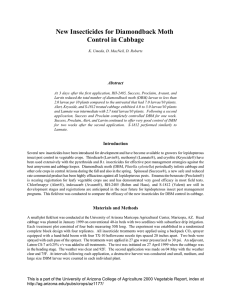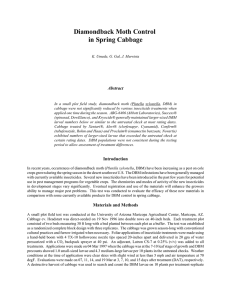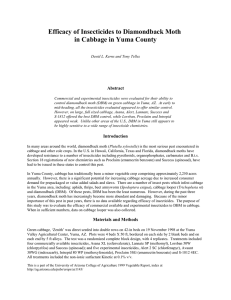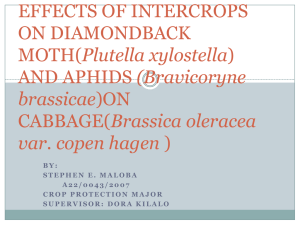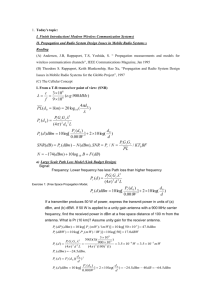Diamondback Moth Control in Spring Cabbage Study Abstract
advertisement
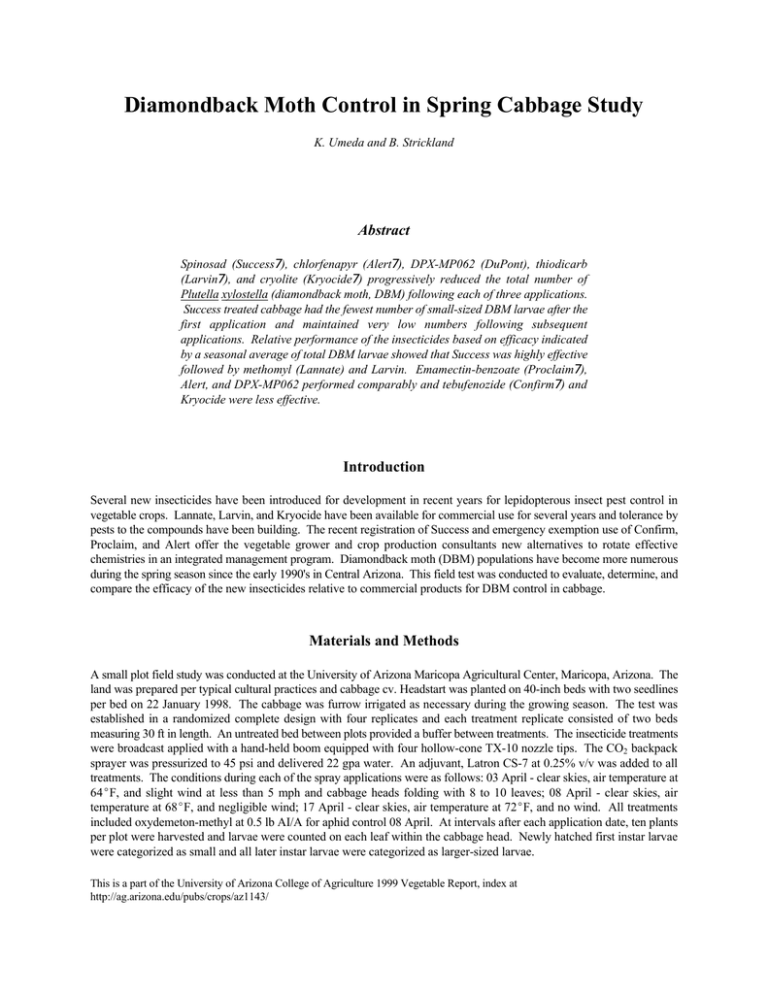
Diamondback Moth Control in Spring Cabbage Study K. Umeda and B. Strickland Abstract Spinosad (Success7), chlorfenapyr (Alert7), DPX-MP062 (DuPont), thiodicarb (Larvin7), and cryolite (Kryocide7) progressively reduced the total number of Plutella xylostella (diamondback moth, DBM) following each of three applications. Success treated cabbage had the fewest number of small-sized DBM larvae after the first application and maintained very low numbers following subsequent applications. Relative performance of the insecticides based on efficacy indicated by a seasonal average of total DBM larvae showed that Success was highly effective followed by methomyl (Lannate) and Larvin. Emamectin-benzoate (Proclaim7), Alert, and DPX-MP062 performed comparably and tebufenozide (Confirm7) and Kryocide were less effective. Introduction Several new insecticides have been introduced for development in recent years for lepidopterous insect pest control in vegetable crops. Lannate, Larvin, and Kryocide have been available for commercial use for several years and tolerance by pests to the compounds have been building. The recent registration of Success and emergency exemption use of Confirm, Proclaim, and Alert offer the vegetable grower and crop production consultants new alternatives to rotate effective chemistries in an integrated management program. Diamondback moth (DBM) populations have become more numerous during the spring season since the early 1990's in Central Arizona. This field test was conducted to evaluate, determine, and compare the efficacy of the new insecticides relative to commercial products for DBM control in cabbage. Materials and Methods A small plot field study was conducted at the University of Arizona Maricopa Agricultural Center, Maricopa, Arizona. The land was prepared per typical cultural practices and cabbage cv. Headstart was planted on 40-inch beds with two seedlines per bed on 22 January 1998. The cabbage was furrow irrigated as necessary during the growing season. The test was established in a randomized complete design with four replicates and each treatment replicate consisted of two beds measuring 30 ft in length. An untreated bed between plots provided a buffer between treatments. The insecticide treatments were broadcast applied with a hand-held boom equipped with four hollow-cone TX-10 nozzle tips. The CO2 backpack sprayer was pressurized to 45 psi and delivered 22 gpa water. An adjuvant, Latron CS-7 at 0.25% v/v was added to all treatments. The conditions during each of the spray applications were as follows: 03 April - clear skies, air temperature at 64EF, and slight wind at less than 5 mph and cabbage heads folding with 8 to 10 leaves; 08 April - clear skies, air temperature at 68EF, and negligible wind; 17 April - clear skies, air temperature at 72EF, and no wind. All treatments included oxydemeton-methyl at 0.5 lb AI/A for aphid control 08 April. At intervals after each application date, ten plants per plot were harvested and larvae were counted on each leaf within the cabbage head. Newly hatched first instar larvae were categorized as small and all later instar larvae were categorized as larger-sized larvae. This is a part of the University of Arizona College of Agriculture 1999 Vegetable Report, index at http://ag.arizona.edu/pubs/crops/az1143/ Results and Discussion At all rating dates at 3, 4, 5, or 7 days after treatment (DAT), all of the insecticides reduced the number of small, larger-sized (Tables 1 & 2), and total DBM relative to the untreated check. Success, Alert, DPX-MP062, Larvin, and Kryocide progressively reduced the total number of DBM following each application. Confirm treated cabbage showed DBM populations to be not significantly different from the untreated check at all rating dates. The average number of total DBM, 18.8 larvae, was the highest among all treatments. Success treated cabbage had the fewest number of small-sized DBM larvae after the first application and maintained very low numbers following each application. The larger-sized larvae and total number of DBM declined after each application of Success and the cabbage tended to show the fewest number of DBM throughout the season with an average of 4.3 larvae. Proclaim at 4 DAT of the first application reduced the total number of DBM and larger-sized larvae relative to the other treatments. The evaluation at 5 DAT of the second application showed that Proclaim treated cabbage had higher counts of DBM larvae indicating a difference in length of effective control to be between 4 and 5 days. Alert consistently reduced the number of DBM following each of the first two applications. DPXMP062 dramatically reduced the number of small-sized and total DBM larvae following the second application. The total number of DBM larvae was the lowest in DPX-MP062 treated cabbage at up to 7 DAT of the last application. The seasonal average of total DBM in cabbage treated by Proclaim, Alert, and DPX-MP062 were similar with a range from 6.5 to 7.7 larvae per 10 plants. Larvin and Lannate performed similarly at each rating date and the small, large, and total numbers of DBM were comparable. The seasonal average of total larvae was 4.8 and 5.8 which was nearly similar to the performance of Success. Kryocide and Confirm reduced the total DBM larvae only 50% or less compared to the untreated check. DBM control in cabbage was effective by all of the treatments in this test. Relative performance of the insecticides based on efficacy indicated by a seasonal average of total DBM larvae showed that Success was highly effective followed by Lannate and Larvin. Proclaim, Alert, and DPX-MP062 performed comparably and Confirm and Kryocide were less effective. The results demonstrate that the grower and crop consultants will have highly effective insecticides to manage DBM in cabbage in the future. Table 1. Diamondback Moth Control in Spring Cabbage Study at MAC. (Umeda and Strickland) Treatment Rate Mean Number Larvae / 10 plants (lb AI/A) Small-sized DBM Larger-sized DBM 03 Apr 07 Apr 13 Apr 20 Apr 24 Apr 03 Apr 07 Apr 13 Apr 20 Apr 24 Apr Untreated Check 17.3 14.0 12.0 4.8 5.3 3.5 9.5 18.5 13.0 5.0 Confirm 0.125 11.3 9.5 4.8 0.8 7.5 9.5 10.5 3.5 Success 0.09 2.8 2.8 0.0 1.0 5.3 4.3 0.5 1.3 Proclaim 0.01 4.0 6.3 2.5 1.3 2.3 5.5 3.5 1.8 Alert 0.10 5.5 5.5 0.8 0.8 7.3 6.0 3.3 1.5 DPX-MP062 0.065 9.3 2.8 1.8 0.5 5.8 3.5 1.3 1.3 Larvin 1.0 4.5 2.0 0.3 0.8 4.0 4.8 1.8 1.3 Kryocide 7.7 9.8 8.3 1.5 0.3 6.3 6.0 8.3 3.0 Lannate 0.9 5.5 1.3 0.3 1.3 6.3 5.5 1.5 1.5 4.6 4.1 2.8 1.5 3.4 7.0 2.7 2.2 LSD (p=0.05) Application dates: 03, 08, 17 April 1998 Table 2. Spring Cabbage Lepidopterous Insect Pest Control Study at MAC. (Umeda and Strickland) Treatment Rate (lb AI/A) 03 Apr Untreated Check Confirm Success Proclaim Alert DPX-MP062 Larvin Kryocide Lannate 20.8 Mean Number Larvae / 10 plants Total DBM 07 Apr 13 Apr 20 Apr 24 Apr 23.5 18.8 8.0 6.3 12.8 15.0 8.5 16.0 11.8 30.5 19.0 7.0 11.8 11.5 6.3 6.8 14.3 6.8 17.8 15.3 0.5 6.0 4.0 3.0 2.0 9.8 1.8 10.3 4.3 2.3 3.0 2.3 1.8 2.0 3.3 2.8 LSD (p=0.05) 5.6 Application dates: 03, 08, 17 April 1998 * Seasonal average calculated from 4 rating dates. 9.0 4.0 3.0 0.125 0.09 0.01 0.10 0.065 1.0 7.7 0.9 Avg.* 20.5 14.4 4.5 6.8 7.7 6.5 4.8 10.9 5.8
